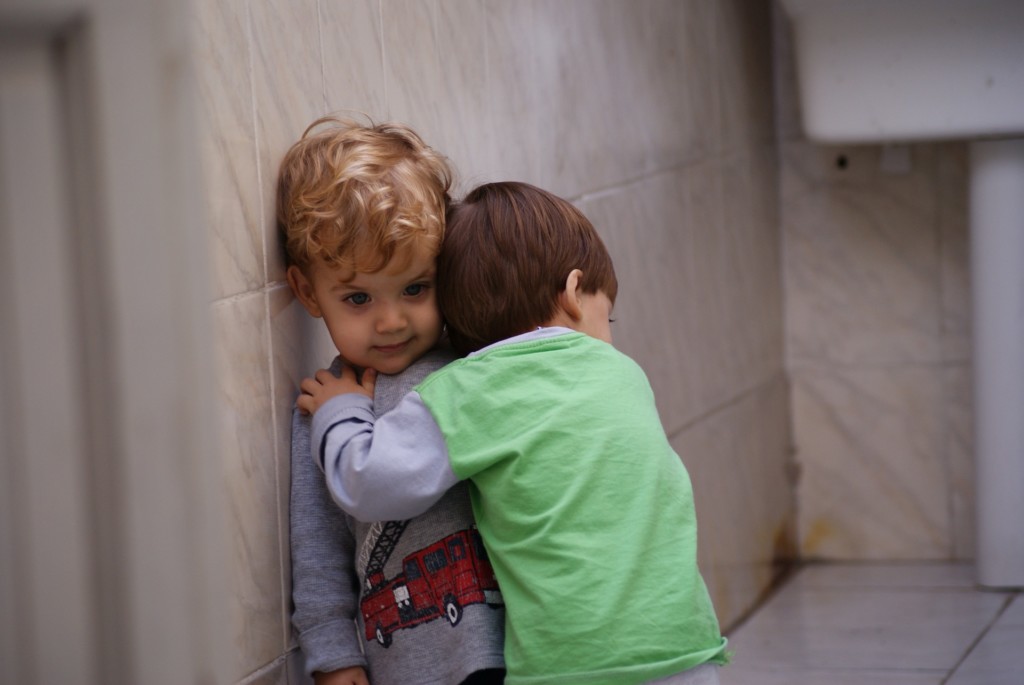
In the wake of the #metoo movement, it seems like a day doesn’t go by without hearing a horrible story of sexual harassment or assault. It’s all over the media and such a hot topic of conversation. There is a lot of conversation about consent and how parents need to talk to tween and teens about what constitutes consent. But I think we can start teaching kids much younger than this, I think it can actually start in infancy. Wait, what? That’s right because it isn’t about sex, it’s about respect and boundaries. Babies and toddlers need to learn how to navigate their body in the world, respect for other bodies, and understand power differentials. We don’t need to wait until our kids are teenagers to start talking about consent, we can start modeling it now. Here are 5 ways I teach my baby and toddler about consent:
1) You don’t have to hug or kiss Grandma. This is probably the one I feel the most passionate about. How often has a well-intentioned relative asked for physical affection and your child hides behind you and refuses? The parent may feel embarrassed and try to convince the child it is rude not to hug their relative and thus push the child towards grandma’s open arms. I distinctively remember the uncomfortable feeling of being forced into a hug I didn’t want to give. This can, albeit unintentionally, send the message that when an adult asks for affection you have to give it. In our house, children have to say hello and goodbye but they can choose to wave, shake hands, or hug. Just because an adult requests physical affection, it doesn’t mean you have to give it. You control when you give affection. No exceptions.
2) I will walk away if I don’t feel safe. My son is a very physical 3-year-old and loves to jump on my back or literally just pile drive me from the side. Needless to say, I don’t enjoy this and I set a limit around this behavior constantly. And as any mom knows, 3-year-olds test these limits over and over. Sometimes I need to walk away and let him know I’m not feeling safe and I need to take care of my body. I want him to see that people shouldn’t stay in situations where they don’t feel safe and it is more than ok to walk away. It’s not a punishment but rather a lesson in modeling safety.
3) Teach your child to check in with their friends during rough play. Did I mention my kid likes to roughhouse? Research shows that roughhousing is great for kids and teaches them tons of good stuff like social skills, boundaries, and emotional intelligence. Sometimes both kids are having fun but I can tell things are looking like they may get too rough. I’ve encouraged my son to ask his playmate “Are you ok with this?” If the play has already become too rough I will intervene and point out the cues from the other kid like “Do you see his face? That face is saying that is too much and I don’t like it.” I may even let the other child know he can tell my son “I don’t like that” or “Stop”. It’s important to help our kids read the non-verbal signs as well as listen to verbal commands to stop.
4) Give me back my baby. This one coincides with the first one but it’s important to know that babies also are aware of their bodies and around 9 months start to develop some major separation anxiety. When my son was that age he didn’t really want to be held by anyone but me or my husband. Sometimes a well-meaning family member or friend would try to entertain him or hold him despite his crying and reaching for me. Even though we know our family and friends are kind people, my baby felt stressed and uncomfortable. My 7-month-old daughter is starting to show early signs of separation anxiety and we are handling it the same way. I want my baby to feel comfortable in her body and honor her request for security whenever possible. If she doesn’t want someone to hold her, we respect that decision whenever possible. My husband and I have definitely received some flack for this one but we feel solid in this choice.
5) Respectful communication is key. I let my kids know what is going to happen when I have to physically move them. So for example, if my toddler won’t go upstairs to bed and is having an epic meltdown, I will often say in a kind voice “You can either walk up on your own or I’ll pick you up and carry you to your room”. He may scream bloody murder and thrash but the point is I let him know that I’m going to move his body in a respectful way. I also tell my baby when it’s time to change her diaper or I show her the lotion before I give her a baby massage to let her know what is happening. Even though she doesn’t quite understand verbal language, I do believe she is starting to understand that I am preparing her for transitions. My hope is that this type of respect for them will inspire them to treat others with respect as well.
I think these 5 little things can start instilling values of respect, personal boundaries, and mutual enjoyment in relationships. This is not a “how to” but rather a work in progress in our house as my son often needs help staying out of others’ space or respecting a physical limit set by someone else. Sometimes my husband and I feel like broken records! We’ve been told “he’s such a boy-it’s just what boys do” but we don’t subscribe to that in our family. Every family member gives and gets the same respect in our house.








